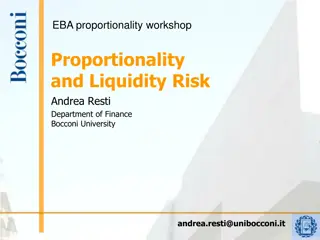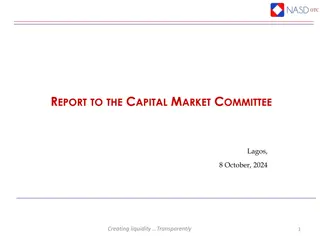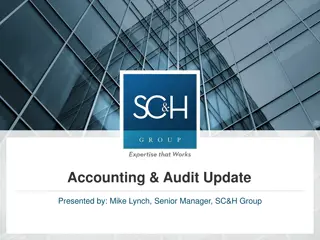Revolutionizing Financial Systems with Aquo Protocol
Aquo aims to integrate global financial systems into a unified protocol, addressing issues like limited liquidity, high costs, and restricted access to diverse assets. By tokenizing Real World Assets and offering innovative solutions, Aquo empowers investors with enhanced liquidity, global access, a
2 views • 10 slides
Understanding Quantitative Credit Control Methods in RBI's Monetary Policy
RBI's monetary policy revolves around maintaining credit quantity in the market through quantitative credit control methods. This includes Bank Rate Policy, Open Market Operations, Cash Reserve Ratio (CRR), and Statutory Liquidity Ratio (SLR). These tools help regulate credit flow, liquidity, and ma
4 views • 8 slides
Overview of Tanzania Mortgage Refinance Company Limited (TMRC)
TMRC is a private financial institution in Tanzania that supports banks in mortgage lending by refinancing their portfolios. It operates as a mortgage liquidity facility for long-term mortgage lending activities by Primary Mortgage Lenders. TMRC's model is based on successful liquidity facilities an
0 views • 22 slides
Understanding Conflict of Interest in ACCME Accredited Activities
Conflict of Interest (COI) refers to financial relationships that may create biases in Continuing Medical Education (CME) activities when individuals have ties to commercial interests and can influence the content. ACCME requires disclosure to prevent potential bias in CME content. Non-disclosure ca
0 views • 18 slides
Federal Agencies Guidance on Ethics, Compliance, and Audit Services under NSPM-33
The White House OSTP released guidance for federal agencies to implement NSPM-33 focusing on disclosure requirements, digital identifiers, consequences for violations, information sharing, and research security programs. The guidance emphasizes supporting open scientific inquiry and nondiscriminator
0 views • 10 slides
Understanding Ratio Analysis in Financial Statements
Ratio analysis is a crucial process in interpreting financial statements by deriving accounting ratios from the balance sheet and profit and loss account. It involves assessing short-term liquidity, long-term solvency, activity ratios, and profitability ratios. Liquidity ratios like current ratio, q
2 views • 41 slides
Efficient Working Capital Management in Businesses
Working capital management involves strategically balancing current assets and liabilities to ensure solvency and maximize asset returns. The main goals include optimizing liquidity, profitability, and resource utilization. Liquidity management is crucial for meeting short-term obligations, and sour
0 views • 27 slides
Understanding Banking Concepts and Monetary Policies
Explore key banking concepts such as Currency Deposit Ratio, Reserve Deposit Ratio, Statutory Liquidity Ratio, High-Powered Money, and their significance in regulating the money supply and liquidity in an economy. These concepts shed light on the relationship between currency, deposits, reserves, an
0 views • 14 slides
Principles of Fiscal Deficits and Debt Management According to Kalecki
Economist Kalecki advocated for a permanent regime of fiscal deficits to manage public debt, emphasizing the importance of debt management for liquidity in the financial system. His principles involve splitting the government budget into functional and financial parts, each influencing aggregate dem
0 views • 6 slides
Semi-Annual Financial Report S2 - 2022 Summary
This report provides key financial data for the second half of 2022, including budgetary execution, fund quotas compliance, member states' balances due, liquidity risk assessment, and more. It outlines the overall program budget execution, quota compliance of member states, and fund liquidity status
0 views • 14 slides
Understanding the Impact of the Insurance Act 2015 on Brokers and Insurers
The Insurance Act 2015 brings significant changes in insurance contract law, shifting from Duty of Disclosure to Fair Presentation. This Act influences both Brokers and Insurers, requiring clear and accessible disclosure of material circumstances. The remedies for misrepresentation and non-disclosur
0 views • 19 slides
Updated Disclosure Rules for Financial Relationships in Continuing Education
ACCME updated its Standards for Integrity and Independence in Continuing Education, requiring disclosure of financial relationships with specific "ineligible companies" by all involved parties. The rules aim to enhance transparency and mitigate conflicts of interest in accredited continuing educatio
1 views • 5 slides
Understanding Disability Disclosure in Employment: Practical and Ethical Considerations
This presentation touches on the practical and ethical issues supported employment professionals face when dealing with disability disclosure. The agenda includes ADA provisions, successful disclosure strategies, the professional's role in the process, and available resources. The session covers dis
0 views • 33 slides
Understanding Disclosure of Adverse Clinical Events in Healthcare
Exploring the essential elements of disclosing adverse clinical events to patients and families in healthcare settings. It covers why disclosure is crucial, barriers to disclosure, triggers for disclosure, policies and procedures, and the other important aspects related to the disclosure process.
0 views • 8 slides
Understanding the Capital Budgeting and Disclosure Process
This content provides a comprehensive overview of the capital budgeting and disclosure process, focusing on fiscal years, budget terms, and the sequential steps involved in the capital budget process. It explains the timeline from the Governor's capital budget release to the final approval by the go
2 views • 23 slides
Example of COI Disclosure Formats in Academic Presentations
These images provide examples of Conflict of Interest (COI) disclosure formats for oral and poster presentations in academic settings. They outline how authors can disclose any potential COIs in relation to their work over the past three years, including details on employment, stock ownership, paten
1 views • 4 slides
Detailed Guidance and Requirements for Implementing NSPM-33
The update provides detailed guidance on implementing NSPM-33's disclosure requirements and other provisions discussed in the January 2022 CLASP Meeting. It includes areas such as disclosure requirements, digital persistent identifiers, consequences for violations, information sharing, and research
1 views • 19 slides
Proportionality Principle in Liquidity Risk Management
The concept of proportionality is essential in evaluating measures related to liquidity risk management in the banking sector. The principle emphasizes the necessity for measures to be appropriate, necessary, and not disproportionally disadvantageous. By applying a 3-stage test, institutions can ens
1 views • 10 slides
Board of External Auditors Presentation Highlights
The presentation by Martin Rubenstein, the Chair of the Board of External Auditors, outlines the responsibilities, membership, and mandate of the board in conducting external audits of the financial accounts of the OAS. Key findings and recommendations regarding accounting practices, liquidity issue
0 views • 6 slides
Transparency in Banking: Examining Disclosure and Regulation
Discussion on the importance of transparency in the banking industry, focusing on the level of information disclosure by banks and its impact on market discipline, lending practices, and regulatory intervention. Papers explore different facets of transparency, including the disclosure audience, natu
0 views • 10 slides
Determinants of Liquidity in the South African Bond Market
The presentation explores the determinants of liquidity in the South African bond market, emphasizing its importance for economic stability and growth. It discusses the significance of market liquidity, impacts of illiquidity, and compares the efficiency of the South African bond market with others
0 views • 24 slides
Evolution of Vulnerability Disclosure Practices
The history of vulnerability disclosure, from the early days of mailing lists and zines to the emergence of Full Disclosure and the debates around anti-disclosure groups. The timeline covers key events like the Morris worm, Code Red, the founding of Bugcrowd, and more, illustrating the evolution of
0 views • 11 slides
Theories of Interest in Microeconomics II
Explore various theories of interest in economics, including the Classical Theory, Liquidity Preference Theory by Keynes, Productivity Theory, Abstinence Theory, Time-Preference Theory, Fisher's Time Preference Theory, and the Loanable Fund Theory. These theories offer different perspectives on the
0 views • 6 slides
Impact of Management of Offenders Act on Disclosure Awareness Session
On 30 November 2020, new legislation including the Age of Criminal Responsibility (Scotland) Act 2019 and the Management of Offenders (Scotland) Act 2019 came into force, transforming the disclosure system in Scotland. These changes raise the age of criminal responsibility, reduce rehabilitation per
0 views • 10 slides
Understanding High Frequency Trading and Mini Flash Crashes
This presentation delves into the world of high frequency trading and mini flash crashes, examining the causes, characteristics, and impacts of these phenomena. Authors Anton Golub, John Keane, and Ser-Huang Poon provide insights and analyses based on extensive research, shedding light on topics suc
0 views • 23 slides
Understanding Liquidity Management and Sukuk Markets
Comprehensive overview of liquidity management (LM), focusing on its importance, obstacles, and current tools like Sukuk. Explore how Sukuk can enhance liquidity management, especially in financial institutions, by matching maturities, maintaining sufficient funds, and dealing with short-term pressu
0 views • 25 slides
Understanding Disclosure of Designs under CDR - Key Insights
The article explores the disclosure of designs under the Community Design Regulation (CDR) and Community Design Invalidity Regulation (CDIR). It discusses the criteria for public availability, evidence required for proving prior disclosure, and the basic rules for establishing the disclosure of a pr
0 views • 9 slides
Use of Credit Default Swaps (CDS) by Investment Funds
Presentation at the ESMA workshop discussed the potential benefits and costs of using Credit Default Swaps (CDS) by investment funds. It highlighted the various uses of CDS, including risk management, alternative liquidity, and investment strategies. Evidence shows that a small percentage of UCITS f
0 views • 6 slides
Gamifying Vulnerability Reporting for Coordinated Disclosure at Microsoft Security Response Center
Christa Anderson, a Senior Security Program Manager at Microsoft's Security Response Center, discusses the importance of gamifying vulnerability report data to encourage coordinated disclosure. The MSRC Top 100, announced at Black Hat USA, plays a crucial role in the public credit strategy by recogn
0 views • 13 slides
Governance Mechanisms and Financial Risks Disclosure in Developing Economies
Examining the impact of governance mechanisms on financial risk disclosure in developing economies, this study delves into theories, literature reviews, findings, policy implications, and conclusions. The research emphasizes the importance of adequate risk disclosure for investor trust and regulator
0 views • 9 slides
The Use of Self in Probation Practice: Understanding Self-Disclosure and Its Implications
Explore the concept of self-disclosure in probation practice, examining different methods, findings, and implications. Discover the two schools of thought regarding self-disclosure and delve into the various realms and subtypes of self-disclosure practices. Gain insights into the forms of self-discl
0 views • 25 slides
Understanding Cultural Influence on Delayed Child Sexual Abuse Disclosure in the Vhavena Tribe
Exploring the intersection of culture, tradition, and delayed disclosure of child sexual abuse within the Vhavena Tribe. The study delves into the complexities of disclosure, the unique context of CSA in cultural norms, and behaviors, guided by the Afrocentric theory. Methodology involves interviews
0 views • 15 slides
Understanding the Call Money Market: Features, Participants, Advantages, and Drawbacks
The call money market is a short-term finance market where loans are provided against a call made by the borrower, often lasting from one day to fourteen days. Major participants include commercial banks, stock brokers, and the Discount and Finance House of India. This market offers high liquidity,
0 views • 5 slides
Enhancing Liquidity in the Capital Market: A Comprehensive Report
This report to the Capital Market Committee covers data and insights on participant growth, market index, activities, traders, institutions, and other market developments as of October 8, 2024. It discusses the progress in creating transparency and liquidity in the market, including upcoming events
0 views • 10 slides
Achieving Liquidity Through Transparent Market Operations in Lagos - Capital Market Committee Report
This report dated 8th October 2024 sheds light on the efforts and progress made in creating liquidity transparently in the market. It covers key aspects such as admitted securities, share capital, dematerialization, trade volume, market leaders, and initiatives for market expansion and enhancement.
0 views • 11 slides
Market Report: Creating Liquidity Transparently in Lagos - October 2024
In the CEO Interactive Session and market reports presented, key metrics like total share capital, volume dematerialized, and operating brokers/firms were analyzed. Trade values, quarterly volumes, and market leaders were also highlighted, providing insights into the market's liquidity. The data sho
0 views • 27 slides
Impact of Political Stability on Equity Trading Costs of Cross-Listed Firms
The research explores the relationship between political stability and equity trading costs of cross-listed firms, highlighting the impact of political institutions, liquidity, and investor protection. It delves into the importance of factors like quality of political institutions, transparency, and
0 views • 24 slides
New Disclosure Rules for Continuing Education
ACCME updated its Standards for Integrity and Independence in Accredited Continuing Education in December 2020, leading to changes in ACLP's disclosure reporting rules. Key changes include reporting only financial relationships with "ineligible companies," extending the reporting period to 24 months
0 views • 5 slides
Financial Statements Project Update on Not-for-Profit Entities
The Financial Statements Project update focuses on improving the presentation of net asset classes and providing better information on liquidity, performance, and cash flows for not-for-profit entities. Decisions made relate to liquidity presentation, operating measures, net assets, cash flows state
0 views • 27 slides
Combined Utility System Liquidity Replacement Finance Summary
Presentation of the Combined Utility System Liquidity Replacement Finance Department's summary for liquidity types, series, banks, and financing programs. Details include CP programs supporting CUS's CIP, VRDBs series, and liquidity agreements with highly rated banks. Recommendations for financing m
0 views • 4 slides







































